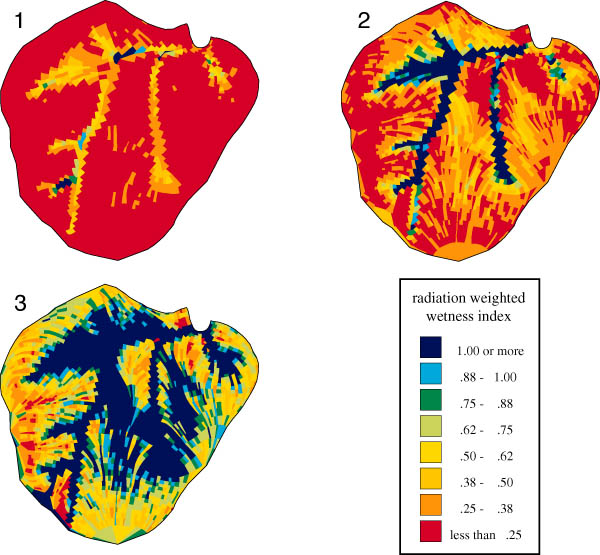 |
|
Tour |
CSIRO intro | copyright | queries | user guide | publications | bug info | data
program code | feedback | search | tour | around the world | workshopsCRCCH
 |
|
Tour |
CSIRO intro | copyright | queries | user guide | publications | bug info | data
program code | feedback | search | tour | around the world | workshopsCRCCH
Shown below are three different predictions of the steady-state radiation-weighted wetness index, defined in equation 4.2 in Chapter 4 of the User Guide and in Vertessy et al. (1990). A value of 1 or higher denotes that the element is saturated, ie. the upslope flux of drainage exceeds the capacity of the element to transmit that flux.
In each case it has been assumed that the soil transmissivity is 1 m/d. What is being varied between simulations is the solar declination term (f). In simulation 1 f is set at -23.5 degrees, denoting the time of summer solstice in the southern hemisphere (ie. maximum radiation). In simulation 2 f is set at 0 degrees, denoting the time of equinox (ie. average radiation). In simulation 3 f is set at 23.5 degrees, denoting the time of winter solstice (ie. minimum radiation).
The percentage of catchment saturated increases from 0.6% for simulation 1, to 10.0% for simulation 2, and 36.1% for simulation 3.

OTHER STEADY STATE BALANCE OUTPUTS
normal wetness index | radiation-weighted wetness index | uniform stream power index
variable stream power index | erosion hazard index | landslide hazard index
shear stress index | sources & sinks
TOPOG TOUR
last modified onThursday, 29 July 1999